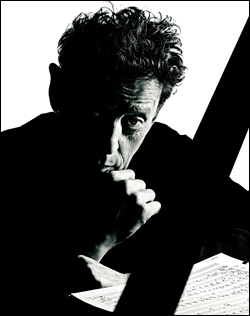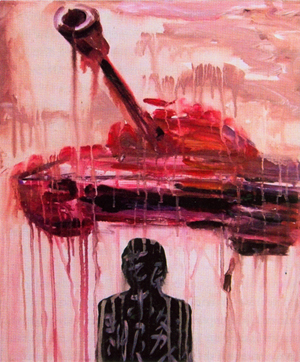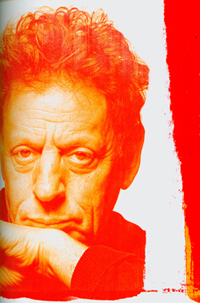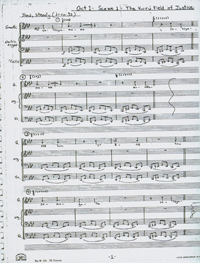
Philip Glass’s opera Satyagraha, written in 1979, depicts the early years of Mahatma Gandhi in South Africa. Born in India in 1869, Gandhi studied law in England before accepting a job to mediate a dispute between two Indian businessmen in South Africa. Here he remained for the next twenty years (1893–1914), developing his strategies of nonviolent transformation, which he called satyagraha. The entire text for Glass’s Satyagraha comes from the Bhagavad Gita, which is a part of the great Indian epic The Mahabharata.
In the Gita, the warrior Arjuna and his charioteer, who is the embodiment of Lord Krishna, charge onto a battlefield where opposing armies stand ready to fight. Suddenly Arjuna is beset by doubt and misgivings, and in response, Krishna delivers some of the greatest spiritual teachings in world history.
Glass’s Satyagraha, first performed in the United States at the Brooklyn Academy of Music in 1981, was the second in a trilogy preceded by Einstein on the Beach and followed by Akhnaten. His latest opera, Appomattox, about the Civil War, premiered at the San Francisco Opera House last October. In April 2008 a new production of Satyagraha will be performed in New York City at the Metropolitan Opera House.
This interview was conducted in Nova Scotia last summer by Tricycle’s founder, Helen Tworkov. Philip Glass is Chair of the Tricycle Foundation’s Board of Directors.
When did you first get interested in Gandhi? In the mid-sixties. I was in northern India, in Kalimpong. I befriended a shopkeeper, Mr. Sarup, who sold rugs out of a little shop on Ten Mile Road. And one day he said, “I have a movie that I want to show you.” He arranged a screening at a little local theater, and it turned out to be an old newsreel of Gandhi’s Salt March. Of course, I already knew who Gandhi was, knew about his life in an anecdotal way. But my response to watching him was, “My God, who is that?” There’s this little guy in a dhoti, with a huge crowd following him—thousands of people—and he wades into the water and takes off his loincloth and dips it into the sea and holds it up. And with that, he disobeys the British law against harvesting salt.
The Salt March always strikes me as the most ingenious piece of street theater ever conceived. Yes. Gandhi was very savvy in that way. This happened in 1930, after he had already been in South Africa for twenty years. That’s where he developed the tools for satyagraha, for nonviolence protests. The marches, filling the jails, burning the registration cards [required of Indian nationals by British rule]—all the things that became the lifeblood of the civil rights movement in America were developed by Gandhi in South Africa in the 1890s.
How did you pursue this interest after Kalimpong? On my next trip to India, in 1969–70, I went to the Gandhi Peace Foundation in New Delhi, and I started to read his autobiography and other volumes of his collected writing. I also went to Ahmedabad—the scene of the 1918 textile mill workers’ strikes, where Gandhi had set up his first ashram, Sabarmati Ashram, when he returned from South Africa.
During Gandhi’s life, the mills were owned by the Sarabhai family. Gandhi supported the workers when they went on strike, although he never lost the support or patronage of the Sarabhai family. But the next generation of Sarabhais became patrons of the arts. I wanted to see the places that Gandhi had been in and to meet people that he had known, and they were happy to take me around.
At just about that time, Erik Erikson published Gandhi’s Truth, in which the mill workers’ strike—or as Erikson calls it, “The Event”—is presented as the pivot that directs Gandhi’s life for the next thirty years. Yet your opera covers Gandhi’s life only in South Africa. Yes, because the development of satyagraha took place in South Africa. By the time Gandhi came back to India he was in his forties, and he knew exactly who he was and what he was going to do.

Were there specific ways that Gandhi affected your own life? That leads us right to the text of the opera itself, which is taken from the Bhagavad Gita. Gandhi had memorized the Bhagavad Gita. The essential question that the warrior Arjuna asks Lord Krishna is: If nondoing and doing are the same, why is the path of action superior to the path of nonaction?
And the Bhagavad Gita gives the answer to that question. Gandhi asked himself that question. And so did Shakyamuni. When the Buddha left the Bodhi Tree after his enlightenment, he met up with his old companions from his days as an ascetic. And they see their old friend, but he looks different. And they ask, “Who are you?” Not as in “What’s your name?” but rather, “What manner of man are you?”
And Shakyamuni answers, “I woke up. I’m the awakened one.” But he got up from the Bodhi Tree trying to figure out what to do with the experience and information that he had. Action? Or inaction? He says, “The knowledge is subtle and hard to understand. What should I do?”
Then he finally decides that he will attempt to teach. So that was Shakyamuni’s answer. And I think it was Gandhi’s answer as well. Though Gandhi’s enlightenment didn’t happen under a Bodhi Tree; it happened on a train in South Africa. He had been hired to mediate a dispute between two families, and he had arrived in Durban with a first-class ticket for a train to Pretoria. He was dressed like an English barrister, in a frock coat, a bowler hat, and patent-leather shoes. But when a white man entered his compartment he called for the conductor, who then told Gandhi he had to move to the section for “coolies” or “coloreds.” Gandhi protested and showed his first-class ticket, but then he was kicked off the train at Maritzburg and ended up in the dirt and the dust and spent the night in a freezing cold station, asking himself what had happened. And that night, he took a vow to reform the laws in South Africa.
At the very end of the opera, Krishna says, “I have come into the world many times.” Then he says, “I have come into the world to set justice on its seat again.” That’s what Gandhi did: he came into the world to set justice on its seat again. And he felt that was his calling. That’s a little bit different from what Shakyamuni Buddha did.
How do you understand the difference? Complete enlightenment has nothing to do with justice. Coming and going, just, unjust—the Middle Way is about the relative and the absolute. Setting justice on its seat again is absolutely about the relative; it has to do with the human condition. The power of Madhyamika Buddhism [a Mahayana school founded by Nagarjuna in the second or third century C.E.] is to understand the relative and the absolute together. When Gandhi talks about setting justice on its seat again, he’s talking about samsara. He’s not talking about emptiness.
Yet I think that for Gandhi—as well as for Martin Luther King, Jr.—justice is a manifestation of unconditional love, not the expression of a political ideology. I think that’s true, but where did Gandhi get his ideas of unconditional love from? The New Testament. He studied Christianity in London. The compassion that’s taught in the New Testament is a very explicit, powerful doctrine. When Jesus says, “When I was hungry, you fed me, when I needed clothes, you clothed me, when I was in jail, you visited me, even as you have done this to my brothers you have done it to me,” that is the most powerful statement of compassion that I know of. I think that that’s where Gandhi’s understanding of justice as love came from. And when Krishna says, “I come to set justice on its seat again”—I think that the underlying idea there combines compassion and love, but that the more complete expression of it is in the New Testament.
At some point King says of his own work, “Jesus supplied the spirit and Gandhi supplied the strategy.” That’s not quite right. King just didn’t know the extent to which Gandhi was influenced by the teachings of Jesus. Now the curious thing about Gandhi is that he understood these things as they applied to his particular community. As far as I know, he had no contact with the black community in South Africa. And in his relationships with his family, he was not a particularly compassionate man. There are a fair number of people like that—people I am pleased to read about and to be inspired by, but I’m happy never to have met them. And Gandhi might have been one of them. He was a difficult man, kind of a tyrant in many ways, and an ideologue. The power of his ideas was the power of his conviction.

What of Gandhi can we use today? Even in terms of India, was he successful? The country that he struggled to create through nonviolence was born of a bloodbath. The answer is: action and nonaction have the same result, but action is superior. Gandhi said as long as there is one man in India who holds onto the truth, the English will have to leave. As long as there is one man who believes in the truth, then the empire will have to collapse, and it did. But Gandhi also understood the power of the media. He understood the impact that holding up his dhoti drenched with seawater would have across the world. He started Indian Opinion in 1904 to advocate for his cause in South Africa, but he made certain that it was mailed all over the world.
But what strategies can we use? Fasting is not part of our culture. Abstinence, various forms of asceticism—these are not going to become our tools for social transformation.The specific techniques are not important. What’s important is focusing on the intent. The intent and the determination are the things that you hold onto. Whether you fill the jails or burn the registration cards—that’s not important. What’s important is unbending intent. That’s what Gandhi had. And unbending intent is more powerful than armies. That’s what King had. This has to be experienced individually. You can’t take a few thousand people and teach that. Unbending intent is inspiring. The power and efficaciousness of it are evident to the people who are inspired, and they become willing to die for the cause.
Gandhi himself, writing about the Bhavagad Gita, says that he understands the battlefield on which the conversation between Arjuna and Krishna takes place to represent not a military conflict but the battle between ignorance and enlightenment. For the opera, how did you understand the battlefield as the backdrop for Gandhi’s life? In the opera, I deal with “the enemy” very obliquely. I never show General Smuts, for example [Gandhi’s adversary in South Africa]. And the last scene of the opera is the night before Gandhi leads the march to the Transvaal. You never see the march. Because I think that “girding” yourself for battle—to use a biblical word—preparing, and undergoing the transformation that is required to ready oneself for battle, is more interesting than the battle itself. The battle is going to happen. You die or you don’t die. The real transformation happens before the battle. To be ready for battle is to have won the battle. I wrote the opera that way because this was my understanding. I don’t mean to say this is a historical perspective.
The three acts of the opera are visually dominated by images of Leo Tolstoy, Rabindranath Tagore, and Martin Luther King; can you speak about that? I was thinking of past, present, and future. I wanted the opera to reflect and be part of a general Hindu-philosophical view of cosmology and human life and so forth. Gandhi’s past was Tolstoy. They corresponded while Gandhi was in South Africa, at the very end of Tolstoy’s life. They never met. But Tolstoy referred to Gandhi as “our brother in the Transvaal.” And Gandhi informed Tolstoy of his work with a community dedicated to social justice—an experiment undertaken by Tolstoy himself in Czarist Russia. In Gandhi’s letters to Tolstoy, you feel that he wants affirmation—Gandhi is still in his twenties—and he gets it.
Tagore, the great poet of Calcutta, was Gandhi’s contemporary. He was by Gandhi’s side during the fasts, during the marches. Gandhi looked upon Tagore as a kind of older brother, but also as a contemporary. And King, we know, was the legacy. The legacy of satyagraha was enacted in America more powerfully than it was ever enacted in India. Unfortunately. The partition of India was a great tragedy for Gandhi, and for India. The abolition of the caste system never really happened, the emancipation of women—most of what he had agitated for never really happened.
Because it’s the sixtieth anniversary of India’s—and Pakistan’s—independence, the press is filled with articles that hark back to 1947 and to the partition. And the current situation in the Middle East has intensified the criticism of the creation of nation-states around religion, because they lend themselves to being breeding grounds for a kind of theocratic fascism. And a lot of this criticism is now going back to Gandhi, and in particular, the way he dealt with Jenna, the head of the Muslim League who agitated for partition. Well, Gandhi was dead set against partition. Looking back, the only way the country could have been held together was through the kind of Civil War that we had in the U.S. They had the battle without the war. They had the pain and suffering, certainly the bloodshed. If there had been a war, they might have had a resolution. Of course, Gandhi himself would never have approved of a war.
Does Gandhi have a particular role to play for American Buddhists who have been very concerned about the direction of our own country? Well, you read about Buddhists engaged in social action all the time.
But for the most part, the engaged activities of Americans new to Buddhism do not go beyond liberal or progressive social action, or Democratic Party politics. Well, I think that’s true.
Does Gandhi have something else to offer? For example, his insistence on always telling his adversaries exactly what his next move would be; on never taking advantage of your enemy when he’s down; on refraining from making gains on the backs of others’ losses. This is a way of being in the world that is very different from working in a homeless shelter or campaigning for your favorite candidate or sending money to the ACLU. Well, I would say, “Even as you fed me, even you as you have clothed me, even as you have visited me in jail, even as you have done all this for my brothers, you have done this for me.” I think that’s what it is. I think there is something very much at the heart of Gandhi in those words. And of course it’s Christian. And that may make it [laughing] a hard pill for us Buddhists to swallow. The thing about people like ourselves is that we are committed to social justice and we’re committed to certain kinds of compassionate behavior, and we would like to think that they are the same. And it may be that we have to think that through more carefully.
How do you understand the ways in which social justice and compassionate behavior may differ? Social justice is an interpretive concept. It’s informed by one’s social standing, by context and personal conditions. At its best, compassion is not dependent on circumstances but is a universal concept, and it has the capacity to cut through social conditioning. In this country, there were those who upheld slavery and who believed that taking good care of their “slave property” benefited the slaves. People on the other side thought that this was an abomination. Both sides thought that they were upholding social justice. I just finished a new opera, Appomattox, about the Civil War, and in it Mrs. Lee is quoted as saying that the freed slaves would look back on their days of bondage as their golden period. But let’s go back to Buddhist activism. Because it’s disappointing.
Why? I think that basically the Buddhist community is a weak community. And it’s weak because it’s guided by self-interests. It’s a feel-good community. It’s what makes “me” feel good. I do it because it makes me feel good.
Compassion makes me feel good. Meditating makes me feel good. It’s not for the welfare of all sentient beings or anything like that. It’s a feel-good movement.
And you think that’s generally true among the “new” or “convert” Buddhists? Yes.
And what would it take to give us a kick in the ass? We’ve had great teachers come our way. And many of them take the view of “Well, we’ll do what we can. We’ll work with what we have to work with.”
Which is? A bunch of narcissistic, materialistic hedonists? You said it. But some improvements can happen. You asked if the Buddhist community has anything to offer. In its present form, it doesn’t. I find the Buddhist community very complaisant, very self-absorbed. Can you imagine any Buddhist that you know actually taking a vow of poverty? What was so inspiring about Gandhi was his unbending intent, his total commitment to his beliefs, and they were palpable, and they were real and they were inspiring. His inner and his outer world were totally one. Who is around now who offers us that?
Even if we had inspiring leaders, are we too far gone to be inspired by them? Are we too stuck in our narcissism and complacency? Can Gandhi today make a difference in any one’s life? On a personal level, sure. On a social level, I don’t know. But you have to start with the personal.
When you wrote Satyagraha, did you have hopes that it could effect any real change?Let’s put it this way: I’m skeptical. Even when I wrote Satyagraha in 1978–79, I was skeptical, but I thought I had to write it anyway because the world was in such turmoil—little did I know what was coming. It’s far worse today. But then it seemed so bad that I thought that we should at least have a dialogue about nonviolence. All I wanted to do was start a conversation.
Ultimately, can it work? I have no idea. I’m still skeptical. But that doesn’t stop me from writing the work. Appomattox, which is a very similar opera, perhaps a little more confrontational. But again, does it make any difference? I just think we have to have the conversation. I’m old enough to have witnessed the failures of people far more evolved and better than I am. Gandhi himself failed in so many ways. King? Did he fail or did he succeed? These are difficult questions, but the point of why we do these things comes back to the Bhagavad Gita: action and nonaction are the same, but action is better. Because action is transformative; we can be sure of that. And with nonaction, we don’t know. So Gandhi chooses action.
Why do I write an opera about Gandhi? Is it going to work? I don’t know. No idea. Probably not. But I’m asking the same question of Krishna: if action and nonaction are the same, which is better? And I come down on the side of action. Surely, I was inspired by Gandhi. I think that the engaged life is the most powerful one. And in that sense we truly become part of our community.
From Act II, Scene 3 of Satyagraha—Liberetto by Constance de Jong and Philip Glass
Ghandi’s prayer: The Lord said:

Let a man feel hatred for no being, let him be friendly, compassionate; done with thoughts of ‘I’ and ‘mine,’ the same in pleasure as in pain, long suffering.
His self restrained, his purpose firm, let his mind and soulbe steeped in Me, let him worship Me with love then will I love in return.
That man I love from whom the people do not shrink and who does not shrink from them, who is free from exaltation, fear, impatience, and excitement.
I love the man who has no expectations, is pure and skilled, indifferent, who has no worries and gives up all selfish enterprise, loyal-and-devoted to Me.
I love the man who hates not nor exults, who mourns not nor desires, who puts away both pleasant and unpleasant things, who is loyal-devoted-and-devout.
I love the man who is the same friend and foe, the same whether he be respected or despised, the same in heat and cold, in pleasure as in pain, who has put away attachment and remains unmoved by praise or blame, who is taciturn, content with whatever comes his way, having no home, of steady mind, but loyal-devoted-and-devout.
But as for those who reverence those deathless words of righteousness which I have just now spoken, putting their faith in them, making Me their goal my loving devotees, these I do love exceedingly.
Satyagraha
An opera in three acts by Philip Glass
Music by Philip Glass
Vocal Text by Constance de Jong (adapted from the Bhagavad Gita)
Book by Philip Glass and Constance de Jong
© 1980 Dunvagen Music Publishers. Used by permission.
♦
Read more interviews with Philip Glass from Tricycle’s Winter 1991 issue and Fall 1999 issue.
Thank you for subscribing to Tricycle! As a nonprofit, we depend on readers like you to keep Buddhist teachings and practices widely available.